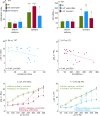Inherent vulnerabilities in monoaminergic pathways predict the emergence of depressive impairments in an animal model of chronic epilepsy
- PMID: 28597913
- PMCID: PMC5554075
- DOI: 10.1111/epi.13822
Inherent vulnerabilities in monoaminergic pathways predict the emergence of depressive impairments in an animal model of chronic epilepsy
Erratum in
-
Erratum.Epilepsia. 2018 Sep;59(9):1810. doi: 10.1111/epi.14553. Epilepsia. 2018. PMID: 30171615 No abstract available.
Abstract
The objective was to determine whether the depression comorbid with epilepsy could be predicted based on inherent premorbid patterns of monoaminergic transmission. In male Wistar rats, despair-like and anhedonia-like behaviors were examined using forced swimming and taste preference tests, respectively. Serotonergic raphe nucleus (RN)-prefrontal cortex (PFC) and dopaminergic ventral tegmental area (VTA)-nucleus accumbens (NAcc) pathways were interrogated by fast scan cyclic voltammetry (FSCV). The assays were performed before and 2 months after pilocarpine status epilepticus. In a subset of naive rats, FSCV, coupled with the intensity-dependent stimulation paradigm, detected specific deviations in each pathway (six rats for RN-PFC and seven rats for VTA-NAcc, with overlap in two, of 19 total subjects) in the absence of behavioral impairments. During epilepsy, animals with preexisting deviations in RN-PFC invariably developed despair, and rats with deviations in VTA-NAcc developed anhedonia. Serotonergic and dopaminergic pathways, respectively, showed signs of explicit deterioration. We suggest that epilepsy triggers decompensations in the already vulnerable depression-relevant neuronal circuits, which culminate in depression. The established connection between the identified specific signatures in monoamine transmission in naive rats and specific symptoms of epilepsy-associated depression may help in understanding causes of comorbidity and in developing its early biomarkers.
Keywords: Biomarkers; Depression; Dopamine; Epilepsy; Serotonin.
Wiley Periodicals, Inc. © 2017 International League Against Epilepsy.
Conflict of interest statement
Figures


References
-
- Kanner AM. Depression in epilepsy: prevalence, clinical semiology, pathogenic mechanisms, and treatment. Biol Psychiatry. 2003;54:388–398. - PubMed
-
- Jentsch MC, Van Buel EM, Bosker FJ, et al. Biomarker approaches in major depressive disorder evaluated in the context of current hypotheses. Biomark Med. 2015;9:277–297. - PubMed
-
- Olbrich S, van Dinteren R, Arns M. Personalized Medicine: Review and Perspectives of Promising Baseline EEG Biomarkers in Major Depressive Disorder and Attention Deficit Hyperactivity Disorder. Neuropsychobiology. 2015;72:229–240. - PubMed
-
- Woods AG, Iosifescu DV, Darie CC. Biomarkers in major depressive disorder: the role of mass spectrometry. Adv Exp Med Biol. 2014;806:545–560. - PubMed
-
- Becker C, Bouvier E, Ghestem A, et al. Predicting and treating stress-induced vulnerability to epilepsy and depression. Ann Neurol. 2015;78:128–136. - PubMed
Publication types
MeSH terms
Substances
Grants and funding
LinkOut - more resources
Full Text Sources
Other Literature Sources
Medical
Miscellaneous

